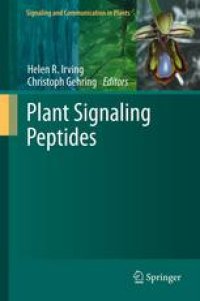
Ebook: Plant Signaling Peptides
- Tags: Plant Biochemistry, Plant Physiology, Protein-Ligand Interactions, Plant Anatomy/Development, Protein Science
- Series: Signaling and Communication in Plants 16
- Year: 2012
- Publisher: Springer-Verlag Berlin Heidelberg
- Edition: 1
- Language: English
- pdf
Plants have evolved with a complex array of signaling molecules to facilitate their growth and development and their interactions with the environment. A vast number of different peptide molecules form an important but until recently often overlooked component amongst these signaling molecules. Plant peptide signals are involved in regulating meristem growth and organogenesis, modulating plant growth and homeostatic responses. They also have important roles as signals of imminent danger or pathogen attack. This volume focuses on the roles of various peptide signaling molecules in development, defence and homeostasis. As it is likely that further plant peptide signaling molecules remain to be discovered, the last section takes a practical look at methods to identify new peptides and characterise their functions.
Plants have evolved with a complex array of signaling molecules to facilitate their growth and development and their interactions with the environment. A vast number of different peptide molecules form an important but until recently often overlooked component amongst these signaling molecules. Plant peptide signals are involved in regulating meristem growth and organogenesis, modulating plant growth and homeostatic responses. They also have important roles as signals of imminent danger or pathogen attack. This volume focuses on the roles of various peptide signaling molecules in development, defence and homeostasis. As it is likely that further plant peptide signaling molecules remain to be discovered, the last section takes a practical look at methods to identify new peptides and characterise their functions.
Plants have evolved with a complex array of signaling molecules to facilitate their growth and development and their interactions with the environment. A vast number of different peptide molecules form an important but until recently often overlooked component amongst these signaling molecules. Plant peptide signals are involved in regulating meristem growth and organogenesis, modulating plant growth and homeostatic responses. They also have important roles as signals of imminent danger or pathogen attack. This volume focuses on the roles of various peptide signaling molecules in development, defence and homeostasis. As it is likely that further plant peptide signaling molecules remain to be discovered, the last section takes a practical look at methods to identify new peptides and characterise their functions.
Content:
Front Matter....Pages i-x
Plant Peptide Signaling: An Evolutionary Adaptation....Pages 1-23
Peptides Regulating Apical Meristem Development....Pages 25-39
Peptides Regulating Root Growth....Pages 41-58
Peptides Regulating Plant Vascular Development....Pages 59-75
The S-LOCUS CYSTEINE-RICH PROTEIN (SCR): A Small Peptide with A High Impact on the Evolution of Flowering Plants....Pages 77-92
Peptides Modulating Development of Specialized Cells....Pages 93-106
Plant Antimicrobial Peptides....Pages 107-133
The Role of Plant Peptides in Symbiotic Interactions....Pages 135-162
Peptides as Danger Signals: MAMPs and DAMPs....Pages 163-181
Peptides and the Regulation of Plant Homeostasis....Pages 183-197
Processing of Peptides....Pages 199-215
Methods to Isolate and Identify New Plant Signaling Peptides....Pages 217-239
Methods to Identify New Partners of Plant Signaling Peptides....Pages 241-256
Computational-Based Analysis to Associate the Function of Plant Signaling Peptides with Distinct Biological Processes....Pages 257-277
Back Matter....Pages 279-284
Plants have evolved with a complex array of signaling molecules to facilitate their growth and development and their interactions with the environment. A vast number of different peptide molecules form an important but until recently often overlooked component amongst these signaling molecules. Plant peptide signals are involved in regulating meristem growth and organogenesis, modulating plant growth and homeostatic responses. They also have important roles as signals of imminent danger or pathogen attack. This volume focuses on the roles of various peptide signaling molecules in development, defence and homeostasis. As it is likely that further plant peptide signaling molecules remain to be discovered, the last section takes a practical look at methods to identify new peptides and characterise their functions.
Content:
Front Matter....Pages i-x
Plant Peptide Signaling: An Evolutionary Adaptation....Pages 1-23
Peptides Regulating Apical Meristem Development....Pages 25-39
Peptides Regulating Root Growth....Pages 41-58
Peptides Regulating Plant Vascular Development....Pages 59-75
The S-LOCUS CYSTEINE-RICH PROTEIN (SCR): A Small Peptide with A High Impact on the Evolution of Flowering Plants....Pages 77-92
Peptides Modulating Development of Specialized Cells....Pages 93-106
Plant Antimicrobial Peptides....Pages 107-133
The Role of Plant Peptides in Symbiotic Interactions....Pages 135-162
Peptides as Danger Signals: MAMPs and DAMPs....Pages 163-181
Peptides and the Regulation of Plant Homeostasis....Pages 183-197
Processing of Peptides....Pages 199-215
Methods to Isolate and Identify New Plant Signaling Peptides....Pages 217-239
Methods to Identify New Partners of Plant Signaling Peptides....Pages 241-256
Computational-Based Analysis to Associate the Function of Plant Signaling Peptides with Distinct Biological Processes....Pages 257-277
Back Matter....Pages 279-284
....


















